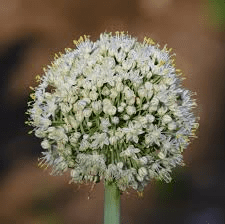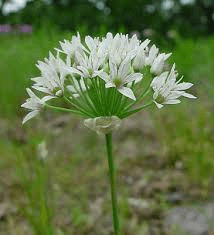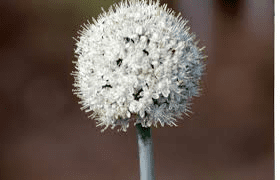The onion umbel is a spherical cluster of small flowers that typically appears at the top of a long, hollow flower stalk called a scape. The scape emerges from the center of the onion plant, rising above the leaves and bulb to support the umbel. The umbel is composed of numerous tiny flowers arranged in a dense, rounded cluster.
Each individual flower in the onion umbel is quite small and has a simple structure. The flowers are usually white or pale purple and have six tepals, which are the outer and inner parts of the flower that are often indistinguishable. In addition to the tepals, each flower contains six stamens with anthers that release pollen and a single pistil with a stigma that receives pollen.
The development of the umbel begins with the elongation of the scape, which supports the growing flower head. As the flowers mature, they open sequentially from the outer edges of the umbel toward the center. This pattern of opening ensures that there is a prolonged period during which pollinators can visit the flowers and facilitate cross-pollination.
Pollination is a crucial aspect of the onion umbel’s function. Onions rely on cross-pollination, meaning pollen from one plant must be transferred to the stigma of another plant’s flowers for fertilization to occur. Pollinators such as bees are attracted to the onion umbel by its scent and nectar. As they move from flower to flower, they transfer pollen, enabling fertilization and seed production.
After successful pollination, the flowers develop into small, dry capsules that contain seeds. Once the seeds are mature, the capsule splits open, allowing the seeds to be dispersed. The seeds can be carried away by wind, water, or animals, and they have the potential to grow into new onion plants under suitable conditions.
The onion umbel also has ornamental value. The spherical clusters of flowers can add a unique aesthetic to gardens and are sometimes used in floral arrangements or as decorative elements. The structure of the umbel and the flowering pattern of onions contribute to their visual appeal and ecological role.
The umbel is a key feature of the onion plant’s reproductive system. Its spherical arrangement of small flowers, supported by a central scape, facilitates effective pollination and seed production. The umbel’s design not only plays a vital role in the onion’s life cycle but also adds beauty and interest to gardens and floral displays.
The Economic Importance and Uses of Onion Umbel

1. Seed Production: The onion umbel, which is the cluster of flowers at the top of the onion plant, is crucial for seed production. It produces onion seeds, essential for growing new onion crops and expanding onion cultivation.
2. Culinary Uses: Onion umbels, while less common in culinary applications, can be used as a garnish or in specialty recipes. They add a unique visual element and a mild onion flavor to dishes.
3. Pollinator Attraction: The onion umbel attracts pollinators such as bees and butterflies, which helps improve pollination rates and supports the health of other plants in the garden.
4. Traditional Medicine: In some cultures, parts of the onion umbel are used in traditional medicine for their perceived health benefits, including their potential anti-inflammatory and antioxidant properties.
5. Ornamental Use: The spherical shape and appearance of the onion umbel make it an attractive addition to ornamental gardens and floral arrangements.
6. Organic Pest Control: The strong aroma of the onion umbel can act as a natural pest repellent, helping to deter certain garden pests and protect other crops.
7. Compost Material: Onion umbels can be added to compost piles. As they decompose, they contribute valuable organic matter and nutrients to the compost mix.
8. Soil Health Improvement: The decomposition of onion umbels adds nutrients to the soil, improving its fertility and structure, which benefits plant growth.
9. Research and Breeding: Onion umbels are important for research and breeding programs. They are studied to develop new onion varieties with improved characteristics and disease resistance.
10. Bioactive Compounds: Onion umbels contain bioactive compounds that are being researched for their potential health benefits, including antimicrobial and antioxidant effects.
11. Natural Dye: The onion umbel can be used to create natural dyes for textiles and crafts, producing colors that are used in various artistic applications.
12. Educational Purposes: Onion umbels are used in educational settings to teach students about plant reproduction, the role of umbels in flowering plants, and the lifecycle of onions.
13. Sustainable Farming: Utilizing onion umbels in crop rotation and integrated pest management helps promote sustainable farming practices and reduces the need for synthetic inputs.
14. Soil Amendment: Added to soil, onion umbels improve soil organic matter, which enhances soil health and plant growth.
15. Ecological Contributions: The onion umbel contributes to ecological balance by supporting beneficial insects and promoting biodiversity in agricultural settings.
16. Aromatic Uses: The aroma of onion umbels can be used in making natural fragrances and essential oils.
17. Medicinal Extracts: Extracts from onion umbels are used in some natural health products for their potential therapeutic properties.
18. Conservation of Plant Species: Preserving onion umbels helps in the conservation of onion varieties and contributes to the overall genetic diversity of the species.
Read Also: 24 Medicinal Health Benefits Of Atriplex argentea (Silverscale Saltbush)
The Products and By-products That Can Be Derived From Onion Umbel

1. Onion Seeds: Produced for planting new onion crops and maintaining cultivation.
2. Culinary Garnishes: Used as a garnish or ingredient in specialty recipes.
3. Pollinator Habitat: Provides habitat and food for pollinators like bees and butterflies.
4. Traditional Medicine: Used in traditional remedies for perceived health benefits.
5. Ornamental Arrangements: Used in floral arrangements and garden displays for visual appeal.
6. Organic Pest Repellent: Acts as a natural deterrent for garden pests.
7. Compost Material: Added to compost piles to enrich the compost mix.
8. Soil Fertilizer: Decomposes to improve soil fertility and structure.
9. Research Material: Studied for breeding programs and development of new onion varieties.
10. Natural Dye: Used to create dyes for textiles and crafts.
11. Bioactive Extracts: Extracts used in health products for potential therapeutic benefits.
12. Educational Tools: Used to teach about plant reproduction and the role of umbels.
13. Sustainable Farming Inputs: Contributes to sustainable farming practices and crop rotation.
14. Soil Amendment: Added to soil to increase organic matter and improve plant growth.
15. Ecological Contributions: Supports beneficial insects and promotes biodiversity.
16. Aromatic Products: Used in making natural fragrances and essential oils.
17. Medicinal Extracts: Incorporated into natural health products for therapeutic uses.
18. Conservation Efforts: Helps in the conservation of onion species and genetic diversity.
Read Also: 7 Medicinal Health Benefits Of Cryptantha crassisepala (Thicksepal Catseye)
Frequently Asked Questions (FAQ’s) About Onion Umbel

1. What is an onion umbel? An onion umbel is the cluster of small flowers that forms at the top of the onion plant, producing seeds.
2. How is the onion umbel used in culinary applications? The umbel can be used as a garnish or ingredient in specialty dishes, adding a unique visual and flavor element.
3. What benefits does the onion umbel provide for pollinators? It attracts pollinators such as bees and butterflies, which helps improve pollination rates and supports garden health.
4. Can onion umbels be used in traditional medicine? Yes, parts of the onion umbel are used in some traditional remedies for their potential health benefits.
5. How does the onion umbel contribute to soil health? When decomposed, it adds organic matter and nutrients to the soil, improving its fertility and structure.
6. Can the onion umbel be used for pest control? Yes, its strong aroma can help repel certain garden pests.
7. How is the onion umbel utilized in research and breeding? It is studied to develop new onion varieties with improved traits and resistance to diseases.
8. Are there ornamental uses for onion umbels? Yes, their spherical appearance makes them attractive for floral arrangements and garden displays.
9. What bioactive compounds are found in onion umbels? They contain compounds that may have antimicrobial and antioxidant properties.
10. How can onion umbels be used in sustainable farming? They support sustainable practices through crop rotation, pest management, and promoting ecological balance.
Read Also: How to Make Money from Computer Recycling

